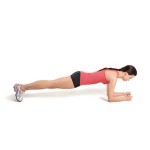Plank!
Strengthen the many layers of your core musculature by adding Planks into your fitness routine.
From a prone position, place your forearms on the floor with your elbows directly below your shoulders. Tuck your toes under and lift your body up off of the floor so your body is parallel to the floor. Pull your shoulders down into your body. Pull your belly button up. Tuck your chin into your chest to maintain spinal alignment.
From the basic plank position, many options exist for progressions:
Alternate lifting your right foot, then your left foot up of the floor.
Lift and hold one leg up off the floor.
Perform a plank with your hands on the floor instead of your forearms.
*Always consult a physician before beginning exercise.
 Subscribe
Subscribe
